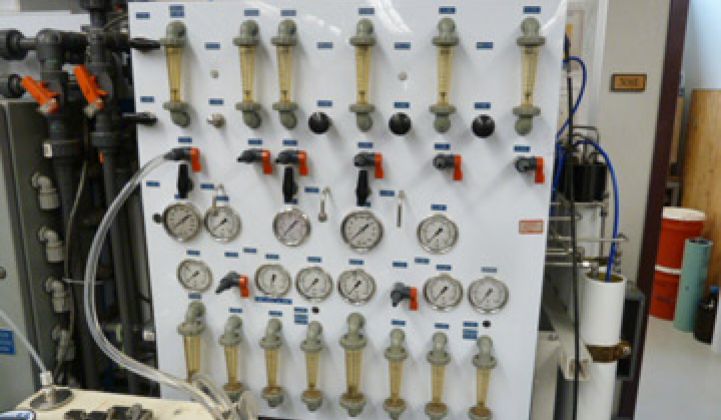Reno, Nev.--You could call this water recycling squared.
Amy Childress, a professor at the University of Nevada Reno, and a group of researchers are experimenting with a method that essentially harnesses the hidden power of waste streams to turn sea or swamp water into something you could possibly drink.
In theory, it could offset 50 percent of the energy required in reverse osmosis (RO) desalination, she said. The fifty percent figure is just in theory, she added for further emphasis, but any progress in reducing the power consumed in desalination would be welcome. Energy -- which is used to pressurize water so that an RO membrane will fleece the salt and other impurities -- can account for around two-thirds of the operating costs of a desal plant, according to general industry estimates. ("Current electricity use in seawater RO plants, including pretreatment, is approximately 3.73 kWh/ m3, with approximately 2.41 kWh/ m3 for the RO separation. The lowest demonstrated use for RO, excluding pretreatment, has been just below 1.6 kWh/ m3," wrote Aaron Mandell and Rob McGinniss from forward osmosis company Oasys in a recent article for us.)
The UNR concept works as follows. A standard RO plant for converting seawater into fresh water would be erected. It would function like a standard plant. Next to it would be a pressure retarded osmosis (PRO) plant. In this plant, lightly- to moderately-fouled water like sewer water would be directed to a reservoir. At one end of the reservoir would be an RO membrane. On the other side of the membrane would be an extremely salty solution. It could be the brine discharge from the principle RO plant.
Nature, and water, seek an equilibrium, so the lightly salted water would push itself through the membrane to the briny side in a vain effort to achieve saline equilibrium. The flow of water to the briny side would create pressure. Think of what happens when you eat salty food and get the sudden urge to drink water. You get bloated and distended. Same thing happens here.
In a PRO plant, however, that pressure could be used to pressurize water flowing into the main osmosis plant. (One could also insert a water column between the moderately- and seriously-fouled water supplies and get the same results.) In the end, you essentially exploit two dirty sources of water to recycle another one.
The technique shares a lot in common with other desalination concepts we've covered here. Energy Recovery, for instance, harvests the pressure from discharged waste streams in RO plants to pressurize incoming water. The pressure harvested by Energy Recovery comes from the mechanical pressure applied to the water and not chemical/physical attraction, and it must be harvested from the waste streams as they jet from the RO plant. Thus, you could combine and Energy Recovery system with this technique.
Oasys, meanwhile, takes advantage of chemical attraction with its forward osmosis technology. Oasys uses chemical attraction for osmosis itself and not pressure harvesting. Finally, it's also like the osmotic pressure gradient created by Statkraft. in an ongoing trial in Norway, Statkraft harvests the pressure created by fresh water crossing a membrane to produce electric power. Childress and her group are doing the same thing, but instead of turning the pressure into power, and thus losing some energy in the conversion, they are directly using the pressure. (Childress pointed out that UNR's system and the Statkraft system are currently the world's two osmotic pressure gradients.)
"The main advantage is to produce drinking water at a reduced cost. Other benefits include brine dilution prior to ocean discharge and concentration/treatment of the impaired water source," wrote Andrea Achilli, a graduate student on the project in an email after our field trip. "It is also worth noting that the RO feed water is not diluted with impaired/waste water; it is comprised of only seawater, so this system does not represent a direct or indirect water reuse system. We simply recover the chemical water potential of the impaired water and transfer it to the seawater."
Childress is also conducting experiments on thermal desalination in which low-grade geothermal heat can be injected into salt at the bottom of reservoirs. Last week, I spent some time in Nevada and have some geothermal stories coming up. (Disclosure: I grew up in Reno, but, no, I do not carry money around in a big plastic bucket.)
Final extra tidbit: this piece of machinery comes from Childress' lab. NASA used to own it. Remember those experiments to develop drinking water from the urine of astronauts? You're looking at the machine that NASA employed.



